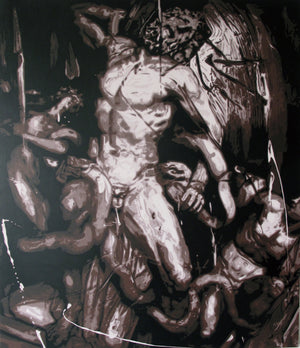Blind Man
Guo Wei
Artwork Details
Artwork Description
Title: Blind Man
Artist: Guo Wei
Date: Undated
Medium: Oil on canvas
Dimensions: 98.4 x 78.7 in. (250 x 200 cm)
1. Artwork Identification
Blind Man by Guo Wei is a monumental oil on canvas composition rendered in a striking monochromatic palette. The central figure, modeled on classical sculpture, is portrayed in a moment of intense physical and emotional tension, with serpentine forms ensnaring his limbs and contorting his posture. Executed with dramatic chiaroscuro and expressive, almost gestural paint handling, the work recalls ancient Greco-Roman forms while reimagining them through a contemporary psychological lens. The sheer scale of the piece commands attention, amplifying its emotional impact.
2. Artistic Style and Influences
Guo Wei’s visual language is deeply rooted in the traditions of Socialist Realism, but it is tempered with the psychological nuance of Neo-Expressionism. The painting’s sculptural references allude to the Hellenistic masterpiece Laocoön and His Sons, evoking themes of human struggle, fate, and sacrifice. Yet the execution is unmistakably modern—raw, visceral, and emotionally fraught—suggesting the spiritual entrapment of the modern individual. The ambiguous gaze and contorted body further distance the work from idealized heroism, instead portraying the fragility of the self in a fractured world.
3. Historical Context
Emerging from China’s post-Cultural Revolution art scene, Guo Wei belongs to a generation of artists whose work reflects a shift from collectivist ideology to personal identity and emotional introspection. The 1980s and 1990s saw increasing urbanization, economic liberalization, and a growing tension between traditional values and modern anxieties. Blind Man, though undated, appears to channel these tensions, offering a layered allegory for disorientation and powerlessness in the face of institutional or existential forces. The Title: itself—Blind Man—may reference both literal and metaphorical blindness: to truth, to direction, or to one’s own internal landscape.
4. Provenance
Provenance documentation can be provided upon contact.
5. Condition and Conservation
This artwork is in very good condition. The surface exhibits a stable paint layer with no visible signs of cracking, loss, or abrasion. The canvas is taut and well-mounted. No restoration is currently recommended.
6. Artistic Significance
Blind Man exemplifies Guo Wei’s intellectual and artistic breadth, merging art historical allusion with the psychological unease of contemporary life. While much of Guo’s oeuvre focuses on the alienation of modern Chinese youth, this work expands the theme toward universal human suffering, borrowing the visual weight of antiquity to comment on timeless emotional and spiritual dilemmas. Its grandeur, intensity, and allegorical depth make it a standout piece in Guo Wei’s body of work, appealing to both collectors of Chinese contemporary art and those drawn to psychologically charged figuration with a classical underpinning.


